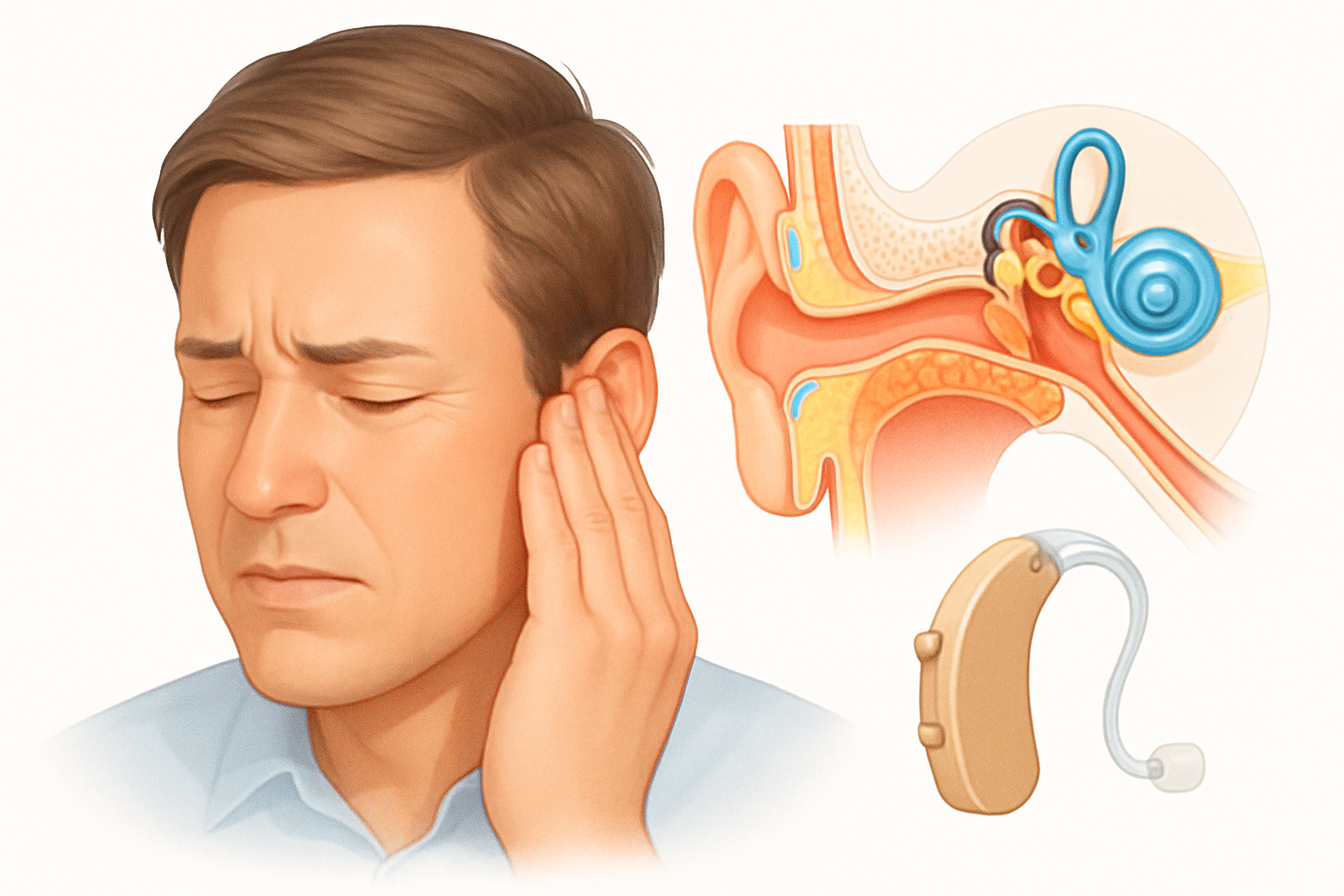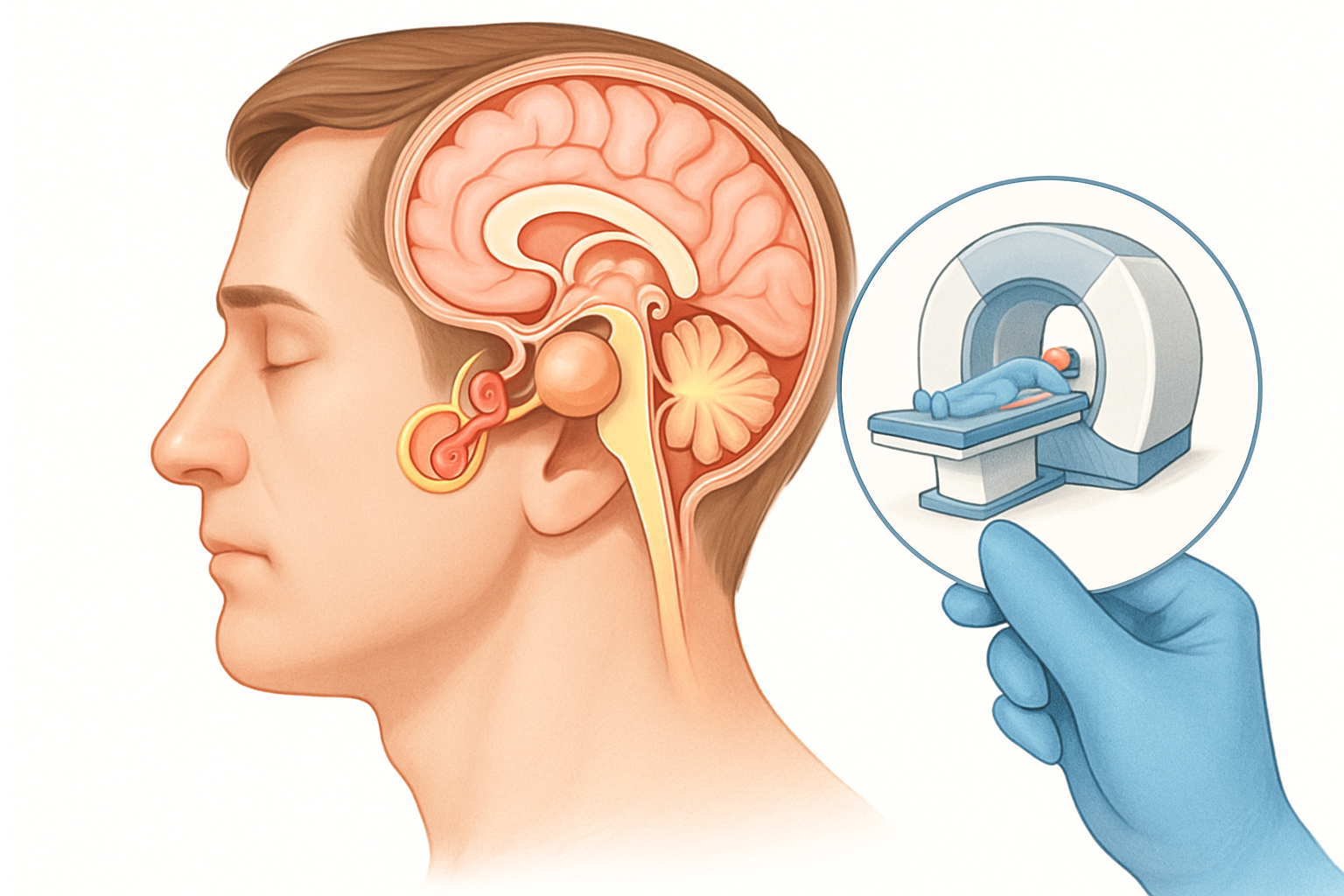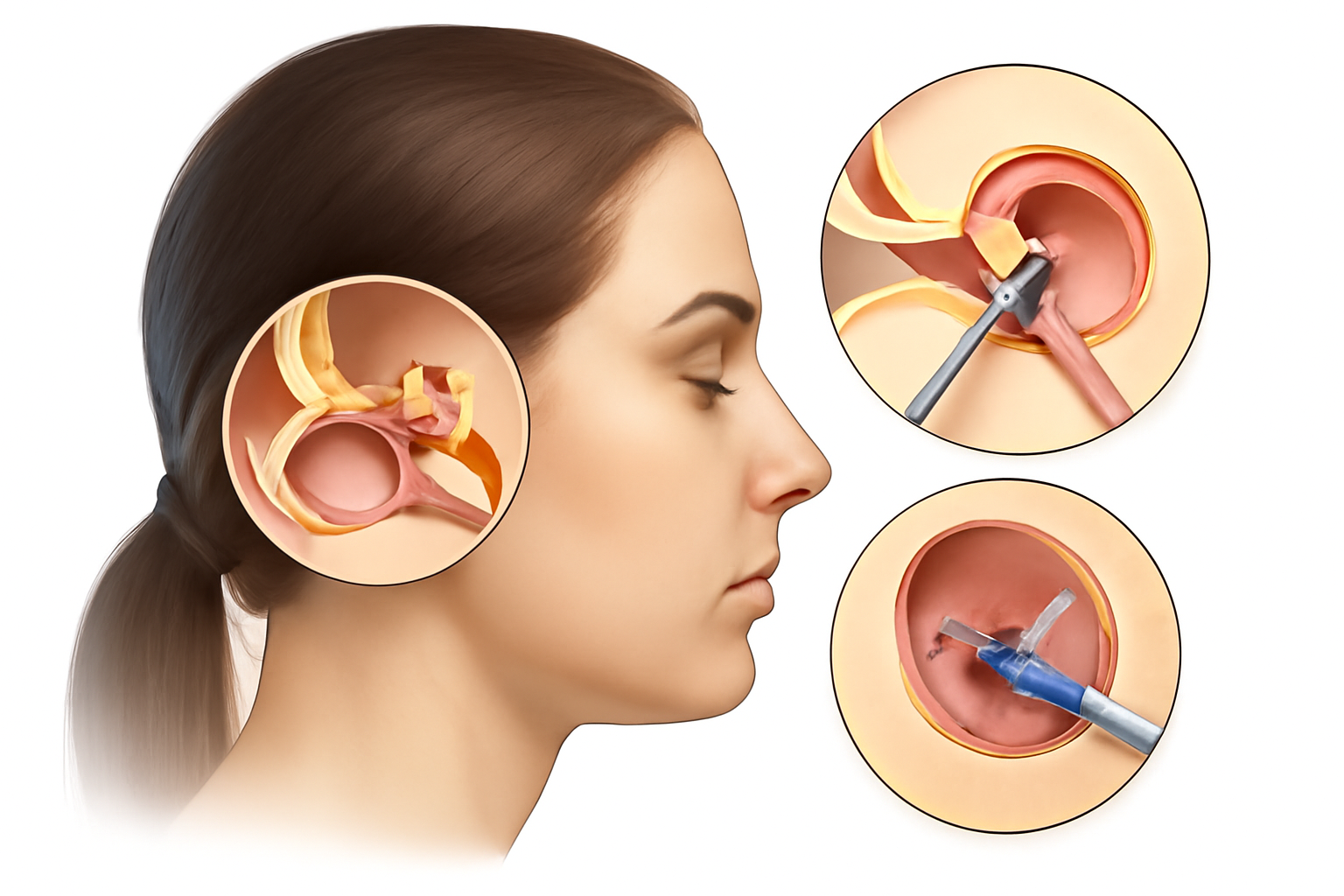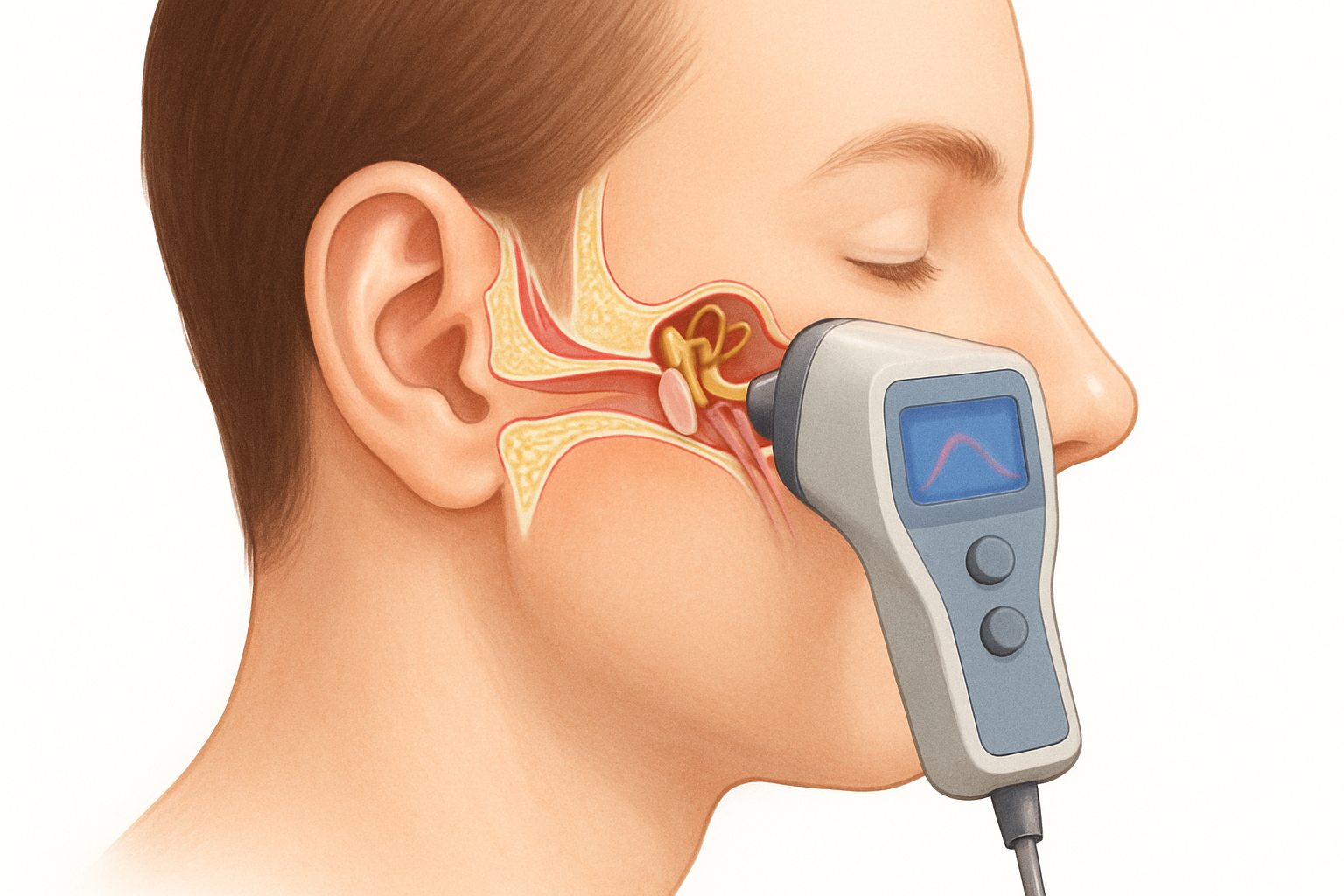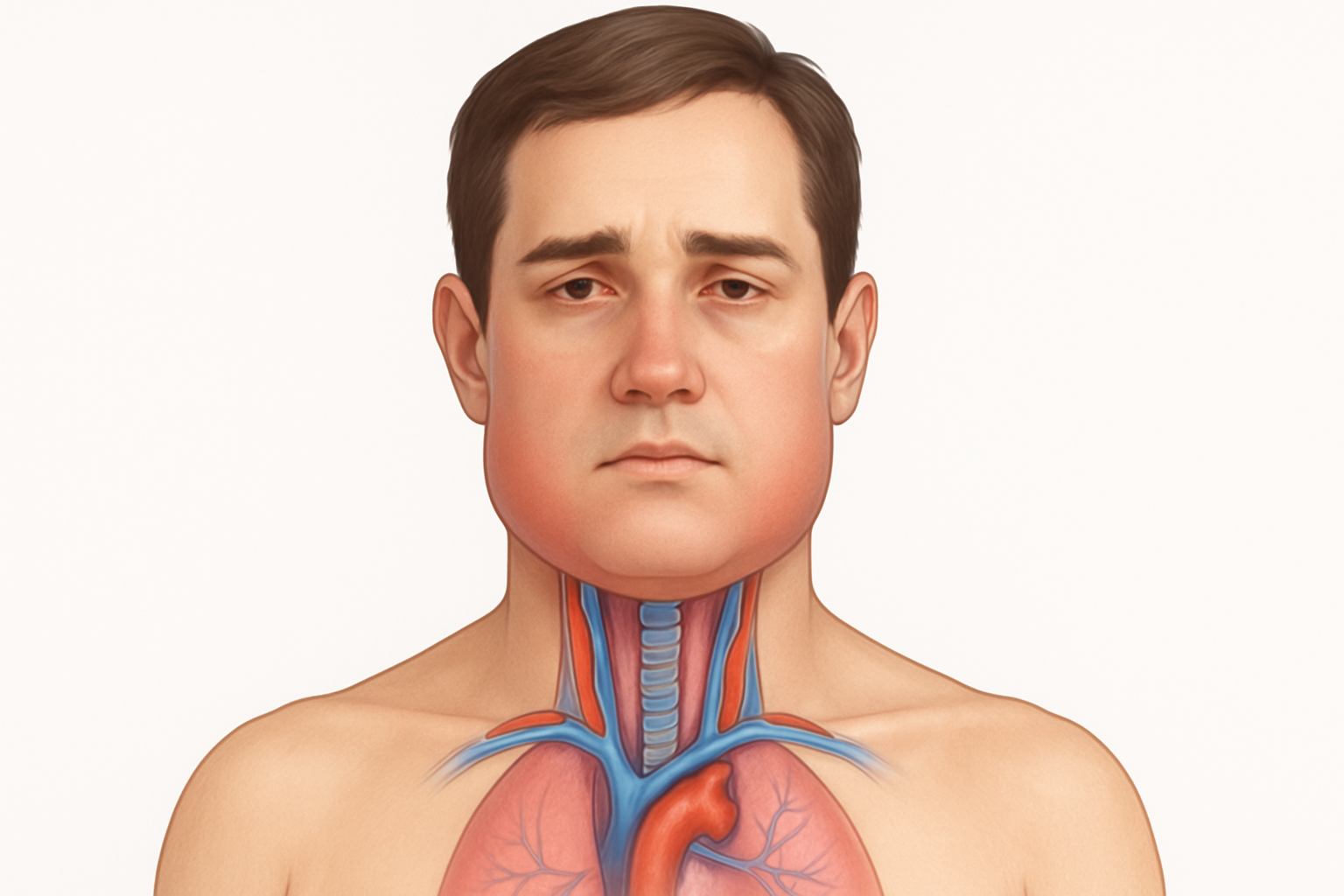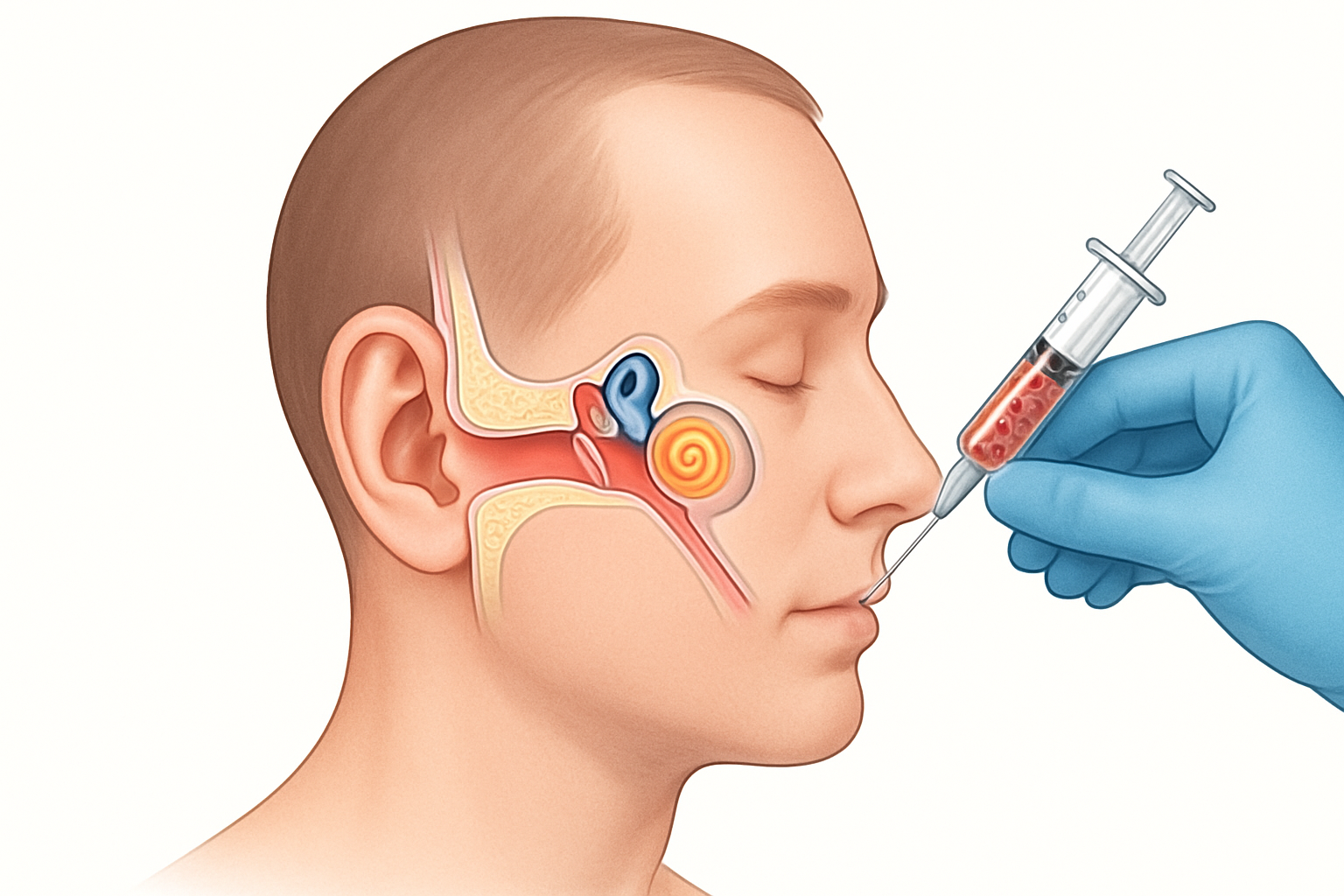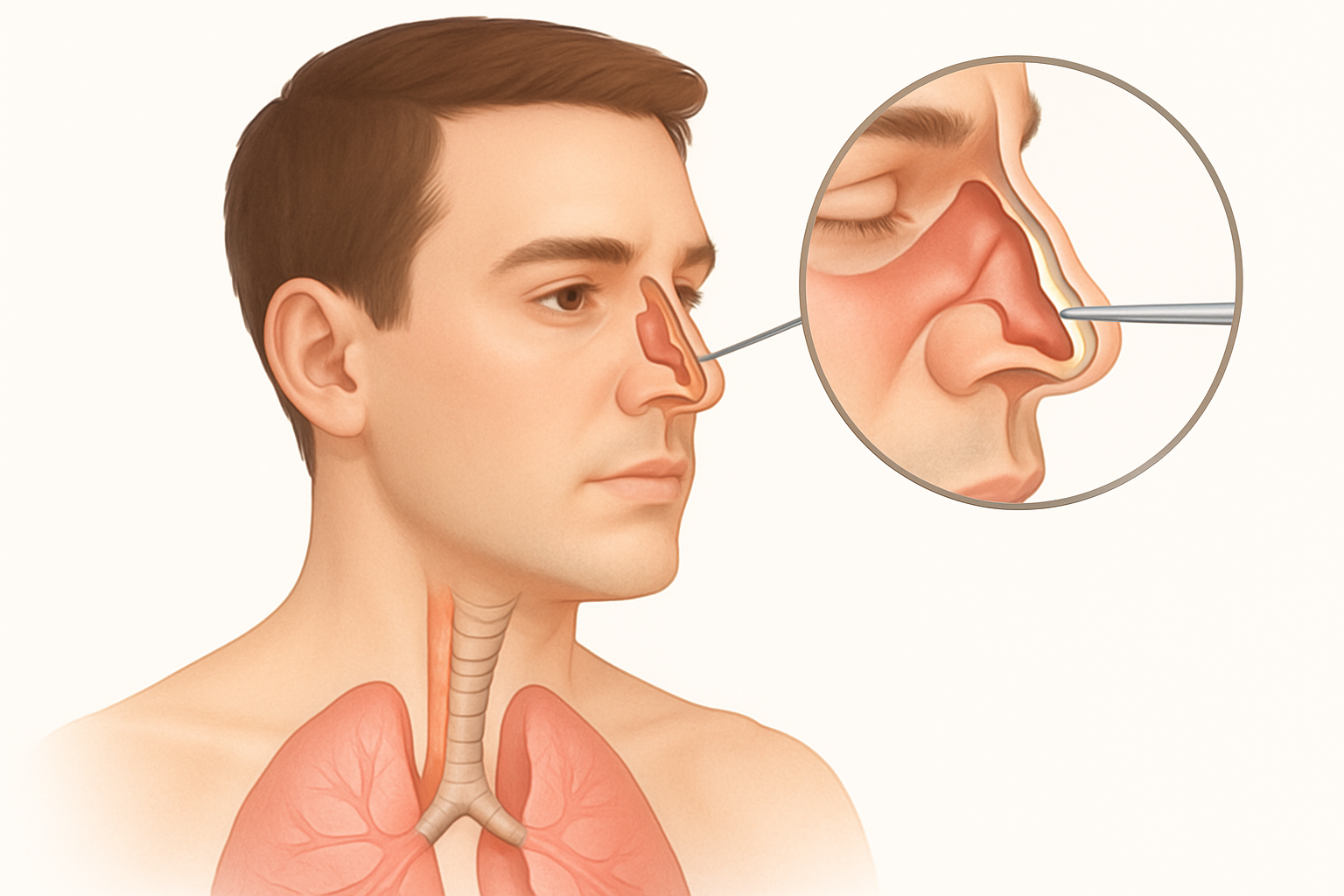دليلك الشامل لضعف السمع الحسي العصبي وعلاجه في تركيا
النقاط الرئيسية
- ضعف السمع الحسي العصبي هو النوع الأكثر شيوعًا من فقدان السمع.
- تشمل الأسباب العمر، التعرض للضوضاء العالية، والعوامل الوراثية.
- تتضمن خيارات العلاج المعينات السمعية وزراعة القوقعة.
- تركيا تقدم رعاية صحية عالية الجودة بأسعار تنافسية.
- تساعد استراتيجيات التواصل الفعّالة في تحسين الحياة اليومية للمرضى.
جدول المحتويات
- مقدمة: فهم ضعف السمع الحسي العصبي وأهميته
- الأسباب وعوامل الخطر للإصابة بضعف السمع الحسي العصبي
- أعراض ضعف السمع الحسي العصبي وكيفية التشخيص
- أحدث العلاجات والاكتشافات لضعف السمع الحسي العصبي
- خبرات المستشفيات التركية في علاج ضعف السمع الحسي العصبي
- نصائح عملية للمرضى وعائلاتهم عند التعامل مع ضعف السمع الحسي العصبي
- اتصل بنا للحصول على استشارة طبية
- المراجع
يعتبر ضعف السمع الحسي العصبي (Sensorineural Hearing Loss – SNHL) حالة طبية تؤثر على ملايين الأشخاص حول العالم، وتتراوح شدتها من خفيفة إلى عميقة، مما يؤثر بشكل كبير على جودة حياة الفرد وقدرته على التواصل. في هذا الدليل الشامل، سنستكشف كل ما يتعلق بضعف السمع الحسي العصبي، بدءًا من أسبابه وأعراضه، مرورًا بأحدث خيارات العلاج المتاحة، وصولًا إلى تسليط الضوء على الخبرات الطبية المتقدمة في تركيا، والتي أصبحت وجهة رائدة عالميًا في مجال الرعاية الصحية.
مقدمة: فهم ضعف السمع الحسي العصبي وأهميته
ضعف السمع الحسي العصبي هو النوع الأكثر شيوعًا من فقدان السمع، وينتج عن تلف في الأذن الداخلية (القوقعة) أو في الأعصاب السمعية التي تنقل الإشارات الصوتية من الأذن إلى الدماغ. هذا التلف يمنع انتقال الأصوات بشكل صحيح، مما يؤدي إلى صعوبة في سماع وفهم الكلام، خاصة في البيئات الصاخبة.
لماذا يعتبر هذا الموضوع مهمًا؟
- التأثير على التواصل: القدرة على السمع ضرورية للتواصل الفعال، والذي بدوره يلعب دورًا حاسمًا في العلاقات الشخصية، النجاح الأكاديمي والمهني، والصحة النفسية.
- الارتباط بأمراض أخرى: يرتبط ضعف السمع بزيادة خطر الإصابة بأمراض أخرى مثل الخرف، الاكتئاب، القلق، وزيادة احتمالية السقوط لدى كبار السن.
- التطورات العلاجية: تشهد مجالات طب الأنف والأذن والحنجرة وزراعة القوقعة تطورات مستمرة، مما يوفر أملًا جديدًا للمصابين.
- الرعاية الصحية في تركيا: تقدم تركيا حلولًا طبية عالية الجودة وبأسعار تنافسية، مما يجعلها خيارًا جذابًا للمرضى الباحثين عن أفضل رعاية لضعف السمع.
الكلمات المفتاحية الهامة: ضعف السمع الحسي العصبي، علاج ضعف السمع، زراعة القوقعة، سمع الأذن، مشاكل السمع، أسباب ضعف السمع، أعراض ضعف السمع، أفضل مستشفيات السمع في تركيا، الرعاية الصحية في تركيا، شبكة ريهابتورك للرعاية الصحية، استشارة طبية للسمع.
الأسباب وعوامل الخطر للإصابة بضعف السمع الحسي العصبي
يمكن أن تنجم مشكلات ضعف السمع الحسي العصبي عن مجموعة واسعة من العوامل، بعضها يتعلق بالعمر، والبعض الآخر بعوامل وراثية أو بيئية. فهم هذه الأسباب يساعد في الوقاية والتشخيص المبكر.
الأسباب الشائعة لضعف السمع الحسي العصبي:
- التقدم في العمر (فقدان السمع المرتبط بالعمر – Presbycusis): هذا هو السبب الأكثر شيوعًا لضعف السمع الحسي العصبي. مع تقدم العمر، تتدهور الخلايا الشعرية الدقيقة في الأذن الداخلية تدريجيًا، وهي المسؤولة عن ترجمة الموجات الصوتية إلى إشارات كهربائية يمكن للدماغ تفسيرها. يبدأ هذا التدهور عادةً في سن متقدمة وقد يتطور ببطء على مدى سنوات.
- التعرض للضوضاء العالية (فقدان السمع الناجم عن الضوضاء – Noise-Induced Hearing Loss – NIHL): التعرض المستمر أو المفاجئ لأصوات عالية جدًا يمكن أن يتلف الخلايا الشعرية في الأذن الداخلية بشكل دائم. يشمل ذلك الأصوات الناتجة عن الآلات الثقيلة، الموسيقى الصاخبة، الألعاب النارية، وحتى سماعات الأذن عند استخدامها بمستوى صوت مرتفع لفترات طويلة.
- العوامل الوراثية: تلعب الوراثة دورًا هامًا في ضعف السمع. يمكن أن يولد الشخص بسمع ضعيف بسبب طفرات جينية تؤثر على بنية أو وظيفة الأذن الداخلية أو العصب السمعي. في بعض الحالات، قد يظهر فقدان السمع المرتبط بالوراثة في وقت مبكر من الحياة، وفي حالات أخرى قد يتطور لاحقًا.
- بعض الأدوية (السمية الأذنية – Ototoxicity): بعض الأدوية، خاصة تلك المستخدمة في علاج السرطان (مثل السيسبلاتين)، والمضادات الحيوية القوية (مثل الأمينوغليكوزيدات)، وبعض الأدوية المستخدمة لعلاج أمراض القلب، يمكن أن تلحق الضرر بالأذن الداخلية وتسبب ضعف السمع.
- الأمراض والالتهابات:
- التهاب السحايا: يمكن أن يؤثر التهاب الأغشية المحيطة بالدماغ والحبل الشوكي على العصب السمعي.
- النكاف والحصبة: هذه الأمراض الفيروسية يمكن أن تسبب فقدان السمع كأحد مضاعفاتها.
- مرض مينيير (Meniere’s Disease): اضطراب يؤثر على الأذن الداخلية، ويسبب نوبات من الدوار، طنين الأذن، الشعور بالامتلاء في الأذن، وفقدان السمع التدريجي.
- أورام العصب السمعي (Vestibular Schwannoma / Acoustic Neuroma): وهي أورام حميدة تنمو على العصب السمعي، ويمكن أن تضغط عليه وتؤثر على السمع والتوازن.
- التصلب المتعدد (Multiple Sclerosis): يمكن أن يؤثر على المسارات العصبية في الدماغ، بما في ذلك المسارات السمعية.
- إصابات الرأس: الصدمات الشديدة على الرأس، خاصة تلك التي تؤثر على قاعدة الجمجمة، يمكن أن تلحق الضرر بالأذن الداخلية أو العصب السمعي.
- مشاكل الدورة الدموية: نقص تدفق الدم إلى الأذن الداخلية، والذي يمكن أن يحدث بسبب أمراض القلب، ارتفاع ضغط الدم، أو السكتات الدماغية، قد يؤدي إلى ضعف السمع.
- أمراض المناعة الذاتية: بعض أمراض المناعة الذاتية، مثل الذئبة أو التهاب الأوعية الدموية، يمكن أن تهاجم الأذن الداخلية.
عوامل الخطر التي تزيد من احتمالية الإصابة:
- التقدم في السن: مع تقدم العمر، تزداد احتمالية حدوث التدهور الطبيعي للأذن.
- المهن التي تتطلب التعرض للضوضاء: العاملون في المصانع، البناء، المطارات، الموسيقيون، وبعض الخدمات العسكرية معرضون بشكل أكبر.
- التاريخ العائلي لضعف السمع: وجود أقارب يعانون من ضعف السمع يزيد من احتمالية الإصابة.
- استخدام بعض الأدوية: التاريخ المرضي لاستخدام الأدوية المعروفة بتأثيرها السمي على الأذن.
- أمراض معينة: الإصابة بأمراض مثل السكري، أمراض القلب، أو ارتفاع ضغط الدم.
- التدخين: تشير بعض الدراسات إلى أن التدخين قد يزيد من خطر الإصابة بضعف السمع.
- التعرض المتكرر للإصابات الرأسية.
فهم هذه الأسباب وعوامل الخطر يساعد في اتخاذ التدابير الوقائية اللازمة، مثل حماية الأذن من الضوضاء، وإجراء فحوصات سمع منتظمة، خاصة لمن هم في الفئات المعرضة للخطر.
أعراض ضعف السمع الحسي العصبي وكيفية التشخيص
يتطور ضعف السمع الحسي العصبي غالبًا بشكل تدريجي، مما يجعل اكتشافه أحيانًا صعبًا في مراحله الأولى. ومع ذلك، هناك علامات وأعراض يمكن الانتباه إليها، ويعد التشخيص الدقيق هو الخطوة الأولى نحو العلاج الفعال.
الأعراض الشائعة لضعف السمع الحسي العصبي:
- صعوبة سماع الأصوات عالية التردد: غالبًا ما تبدأ الصعوبة في سماع الأصوات ذات الترددات العالية، مثل أصوات الطيور، جرس الباب، أو حروف معينة في الكلام مثل “س” و”ف” و”ث”.
- صعوبة فهم الكلام، خاصة في البيئات الصاخبة: قد تسمع الشخص يتحدث، لكنك تجد صعوبة في تمييز الكلمات وفهم ما يقوله، خاصة عندما يكون هناك ضوضاء خلفية (مثل في المطاعم، التجمعات، أو أثناء مشاهدة التلفزيون مع أشخاص آخرين).
- الشعور بأن الآخرين “يتحدثون بصوت مكتوم” أو “غير واضح”.
- الحاجة إلى رفع صوت التلفزيون أو الراديو لمستوى أعلى من المعتاد.
- تجنب التجمعات والمواقف الاجتماعية: بسبب صعوبة التواصل، قد يبدأ الشخص في تجنب المواقف التي تتطلب الاستماع والتركيز.
- طنين الأذن (Tinnitus): الشعور بسماع أصوات رنين، صفير، همهمة، أو أزيز مستمر في الأذن أو الأذنين، قد يكون أو لا يكون مصاحبًا لضعف السمع.
- صعوبة تحديد مصدر الصوت: قد يجد الشخص صعوبة في معرفة من أين يأتي الصوت.
- الدوار أو مشاكل التوازن: في بعض حالات ضعف السمع الحسي العصبي، خاصة تلك المرتبطة بأمراض الأذن الداخلية مثل مرض مينيير، قد يعاني المريض من الدوار.
- الحاجة المتكررة لطلب إعادة الكلام: “ماذا قلت؟” أو “هل يمكنك التكرار؟”
تشخيص ضعف السمع الحسي العصبي:
يعتمد تشخيص ضعف السمع على تقييم شامل يقوم به أخصائي السمع (Audiologist) أو طبيب الأنف والأذن والحنجرة. يتضمن هذا التقييم عادةً:
- التاريخ الطبي المفصل: يقوم الأخصائي بسؤال المريض عن طبيعة الأعراض، متى بدأت، شدتها، التاريخ العائلي لضعف السمع، التعرض للضوضاء، استخدام الأدوية، والأمراض السابقة.
- الفحص البدني: يشمل فحص الأذن الخارجية وقناة الأذن وطبلة الأذن للكشف عن أي علامات تشير إلى مشاكل في الأذن الوسطى أو الخارجية قد تساهم في فقدان السمع (مثل تراكم الشمع، التهابات، أو ثقوب في طبلة الأذن).
- اختبارات السمع (Audiometric Tests): وهي أساس التشخيص وتتضمن:
- قياس سمع النبرة النقية (Pure-Tone Audiometry): هذا الاختبار يقيس قدرة الشخص على سماع الأصوات ذات الترددات المختلفة (من المنخفض إلى العالي) عند مستويات شدة صوت مختلفة. يتم رسم النتائج على مخطط سمعي (audiogram)، والذي يوضح نطاق السمع الطبيعي، ومستوى فقدان السمع (خفيف، متوسط، شديد، عميق)، والترددات المتأثرة. في ضعف السمع الحسي العصبي، غالبًا ما يظهر المخطط فقدانًا في الترددات العالية.
- قياس انبعاثات الأذن الصوتية (Otoacoustic Emissions – OAEs): يقيس هذا الاختبار استجابة الخلايا الشعرية الخارجية في القوقعة للصوت. إذا لم يتم إنتاج انبعاثات صوتية، فهذا يشير إلى وجود مشكلة في الأذن الداخلية. يعتبر مفيدًا بشكل خاص للأطفال والرضع.
- اختبار استجابة جذع الدماغ السمعي (Auditory Brainstem Response – ABR) أو (Brainstem Evoked Response Audiometry – BERA): يقيس هذا الاختبار النشاط الكهربائي في العصب السمعي وجذع الدماغ استجابةً للأصوات. يساعد في تقييم وظيفة العصب السمعي وتحديد مدى فقدان السمع لدى الأشخاص الذين لا يمكنهم إجراء اختبارات السمع التقليدية (مثل الأطفال الصغار جدًا أو الأشخاص الذين يعانون من إعاقات شديدة).
- قياس المعاوقة (Tympanometry): يقيس هذا الاختبار مرونة طبلة الأذن وحركة عظيمات الأذن الوسطى. يساعد في تحديد ما إذا كانت هناك مشاكل في الأذن الوسطى قد تؤثر على السمع.
- اختبارات أخرى (عند الحاجة):
- التصوير بالرنين المغناطيسي (MRI) أو التصوير المقطعي المحوسب (CT scan): قد يوصى بها لاستبعاد أسباب معينة لضعف السمع، مثل أورام العصب السمعي، أو لتقييم بنية الأذن الداخلية والعصب السمعي.
- اختبارات الدم: قد تكون ضرورية للبحث عن أسباب مثل أمراض المناعة الذاتية أو العدوى.
يعتمد التشخيص الدقيق على مجموعة من هذه الاختبارات، ويقوم الأخصائي بتفسير النتائج لتحديد نوع وشدة فقدان السمع، وتحديد الأسباب المحتملة، ووضع خطة علاجية مناسبة.
أحدث العلاجات والاكتشافات لضعف السمع الحسي العصبي
يشهد مجال علاج ضعف السمع الحسي العصبي تطورات مستمرة، مدفوعة بالتقدم في فهم بيولوجيا الأذن الداخلية وعلم الأعصاب، بالإضافة إلى الابتكارات التكنولوجية. في الأشهر الستة الماضية، ظهرت عدة تطورات واعدة، تتراوح بين العلاجات الدوائية الجينية، وتقنيات زراعة القوقعة المحسنة، والعلاجات التجديدية.
العلاجات الحالية والتقليدية:
قبل استعراض أحدث الاكتشافات، من المهم الإشارة إلى العلاجات القياسية التي لا تزال تشكل حجر الزاوية في إدارة ضعف السمع الحسي العصبي:
- المعينات السمعية (Hearing Aids): هي الأجهزة الأكثر شيوعًا لعلاج ضعف السمع الخفيف إلى الشديد. تعمل على تضخيم الأصوات لجعلها أعلى وأكثر وضوحًا للمريض. تتوفر بأشكال وأحجام مختلفة (داخل الأذن، خلف الأذن) وبتقنيات متقدمة تشمل إلغاء الضوضاء وتقليل ردود الفعل (الصفير).
- زراعة القوقعة (Cochlear Implants): هي أجهزة جراحية للأشخاص الذين يعانون من ضعف سمع شديد إلى عميق، حيث لا تكون المعينات السمعية فعالة. تحول زراعة القوقعة الأصوات إلى إشارات كهربائية، ثم تحفز العصب السمعي مباشرة، متجاوزةً الجزء التالف من الأذن الداخلية.
- أجهزة السمع العظمي (Bone Anchored Hearing Aids – BAHAs): تستخدم بشكل أساسي للأشخاص الذين يعانون من مشاكل في الأذن الخارجية أو الوسطى التي تمنع المعينات السمعية التقليدية، أو في حالات ضعف السمع الحسي العصبي أحادي الجانب (في أذن واحدة). تقوم هذه الأجهزة بتوصيل الصوت عبر الاهتزازات إلى عظام الجمجمة، ثم تنتقل إلى الأذن الداخلية.
أحدث العلاجات والاكتشافات (آخر 6 أشهر – مع الإشارة إلى التوجهات البحثية):
تجدر الإشارة إلى أن العديد من العلاجات الثورية لا تزال في مراحل البحث والتجارب السريرية، وقد يستغرق وصولها إلى الممارسة السريرية وقتًا. ومع ذلك، فإن التوجهات البحثية الحالية تشير إلى مستقبل واعد:
- العلاج الجيني (Gene Therapy):
- الاستهداف الجيني للخلايا الشعرية: تركز الأبحاث بشكل كبير على تصحيح الطفرات الجينية المسببة لفقدان السمع الخلقي أو المكتسب. في الأشهر الأخيرة، استمرت الجهود في هذا المجال، مع التركيز على طرق إيصال آمنة وفعالة للعلاج الجيني إلى خلايا الأذن الداخلية.
- دراسة حديثة: تشير الأبحاث المستمرة، مثل تلك المنشورة في دوريات علمية مثل Nature Medicine و Cell Reports (يتطلب التحقق من الأعداد الأخيرة)، إلى تقدم في تقنيات توصيل الجينات (مثل استخدام الفيروسات المعدلة) لاستهداف خلايا محددة في القوقعة. على سبيل المثال، هناك دراسات تستكشف إمكانية إعادة نمو الخلايا الشعرية التالفة أو تحسين وظيفتها عبر تعديل جيني.
- المرجع المفاهيمي: غالبًا ما تتناول هذه الأبحاث استعادة وظيفة جين معين (مثل Atoh1 المسؤول عن نمو الخلايا الشعرية) أو تصحيح جين مسبب للمرض (مثل GJB2 المرتبط بمتلازمة وااردنبورغ).
- النتائج المتوقعة: الهدف هو ليس فقط وقف التدهور، بل استعادة جزء من القدرة السمعية المفقودة.
- العلاجات الدوائية والتجديدية (Regenerative Medicine):
- استعادة الخلايا الشعرية: يتم البحث عن طرق لتحفيز الخلايا الداعمة الموجودة في الأذن الداخلية على التحول إلى خلايا شعرية وظيفية، أو تشجيع نمو خلايا شعرية جديدة.
- العوامل المحفزة للنمو (Growth Factors): يتم دراسة استخدام بروتينات وعوامل نمو معينة يمكن حقنها في الأذن الداخلية لتحفيز إصلاح الخلايا أو إعادة نموها.
- الخلايا الجذعية: هناك اهتمام متزايد بإمكانية استخدام الخلايا الجذعية لإنتاج خلايا شعرية جديدة أو خلايا عصبية سمعية.
- التقدم المحرز: تشير الأبحاث التي تم الإبلاغ عنها في المؤتمرات العلمية الكبرى (مثل Association for Research in Otolaryngology – ARO) إلى تقدم في نماذج الحيوانات، حيث تم إظهار استعادة جزئية للوظيفة السمعية بعد العلاج.
- تحسينات في زراعة القوقعة:
- الشرائح الإلكترودية الأطول والأكثر مرونة: تهدف هذه التحسينات إلى الوصول إلى أجزاء أبعد من القوقعة، مما قد يحسن القدرة على سماع الترددات المنخفضة، وتحسين فهم الكلام.
- التحفيز العصبي المخصص (Personalized Neural Stimulation): تطوير خوارزميات وبرامج أكثر تطورًا لمعالجة الصوت، تسمح بتخصيص التحفيز الكهربائي بشكل أفضل ليناسب الاحتياجات الفردية لكل مريض، مما يحسن جودة الصوت المدرك.
- الأجهزة الهجينة: دمج زراعة القوقعة مع المعينات السمعية أو استخدام التحفيز الصوتي والكهربائي معًا، بهدف تحقيق نتائج سمعية أفضل، خاصة في حالات فقدان السمع المعقد.
- الاتجاهات البحثية: تركز الأبحاث على دمج تقنيات معالجة الإشارات العصبية المتقدمة، وتحسين تصميم الأقطاب الكهربائية لتقليل الضرر النسيجي.
- التقنيات الرقمية والذكاء الاصطناعي (AI):
- تشخيص مبكر ودقيق: تطوير خوارزميات الذكاء الاصطناعي لتحليل أنماط فقدان السمع في مخططات السمع، وتحديد الأسباب المحتملة بدقة أكبر، حتى في المراحل المبكرة.
- تخصيص المعينات السمعية: استخدام الذكاء الاصطناعي لتحليل بيئة الاستماع للمستخدم وتعديل إعدادات المعين السمعي تلقائيًا لتحسين فهم الكلام وتقليل الضوضاء.
- التنبؤ بالاستجابة للعلاج: استخدام نماذج الذكاء الاصطناعي للتنبؤ بمدى نجاح زراعة القوقعة أو المعينات السمعية لدى مريض معين بناءً على بياناته السمعية والفردية.
- الأبحاث المتعلقة بتقليل طنين الأذن:
- الموجات فوق الصوتية المركزة: يتم استكشاف استخدام الموجات فوق الصوتية المركزة منخفضة الشدة لعلاج طنين الأذن المرتبط بضعف السمع الحسي العصبي.
- العلاجات العصبية: دراسة العلاقة بين طنين الأذن واللدونة العصبية في الدماغ، وتطوير علاجات تستهدف هذه التغييرات.
ملاحظة هامة: هذه الاكتشافات البحثية لا تزال قيد التطوير. الاستشارة مع أخصائي طبي هي الطريقة الوحيدة لتحديد العلاج الأنسب لحالتك بناءً على أحدث التطورات المتاحة في الوقت الحالي.
خبرات المستشفيات التركية في علاج ضعف السمع الحسي العصبي
أصبحت تركيا وجهة عالمية رائدة في مجال الرعاية الصحية، خاصة في التخصصات الدقيقة مثل علاج أمراض الأذن والأنف والحنجرة، بما في ذلك ضعف السمع الحسي العصبي. تجمع المستشفيات والمراكز الطبية المتخصصة في تركيا بين الخبرة الطبية العالية، أحدث التقنيات، والرعاية المتميزة للمرضى.
لماذا تبرز تركيا في مجال علاج ضعف السمع؟
- الخبرة العالية للأطباء والجراحين:
- متخصصون ذوو كفاءة: تضم تركيا عددًا كبيرًا من أطباء الأنف والأذن والحنجرة (ENT) وجراحي الأذن (Otologists) وأخصائيي السمع (Audiologists) الذين يتمتعون بخبرة واسعة في تشخيص وعلاج جميع أنواع ضعف السمع، بما في ذلك الحالات المعقدة لضعف السمع الحسي العصبي.
- التدريب الدولي: العديد من هؤلاء الأطباء أكملوا تدريبهم أو حصلوا على شهادات زمالة في مؤسسات طبية مرموقة حول العالم، مما يضمن اطلاعهم على أحدث البروتوكولات والتقنيات.
- التركيز على زراعة القوقعة: تمتلك تركيا مراكز متخصصة في جراحات زراعة القوقعة، مع جراحين أجروا آلاف العمليات بنجاح، وحققوا نتائج ممتازة للأطفال والبالغين.
- التكنولوجيا الطبية المتقدمة:
- أحدث أجهزة التشخيص: تستخدم المستشفيات التركية أحدث أجهزة قياس السمع، أجهزة اختبار استجابة جذع الدماغ السمعي (ABR)، أجهزة قياس انبعاثات الأذن الصوتية (OAEs)، والتصوير المقطعي (CT) والرنين المغناطيسي (MRI) لتوفير تشخيص دقيق وشامل.
- تكنولوجيا زراعة القوقعة: تتوفر أحدث أنواع شرائح زراعة القوقعة من العلامات التجارية العالمية الرائدة (مثل Cochlear، MED-EL، Advanced Bionics)، مع إمكانية الاختيار بين مختلف الأنواع التي تناسب احتياجات المريض.
- معدات جراحية متطورة: تُجرى عمليات زراعة القوقعة وغيرها من جراحات الأذن باستخدام الميكروسكوبات الجراحية الدقيقة، وأدوات الجراحة بالمنظار، وتقنيات الملاحة الجراحية لضمان الدقة وتقليل المخاطر.
- مراكز متخصصة في إعادة التأهيل السمعي:
- برامج تأهيل متكاملة: لا يقتصر العلاج على الجراحة أو الأجهزة، بل يمتد إلى برامج إعادة تأهيل سمعي ونطقي شاملة. يقدم أخصائيو السمع والنطق جلسات تدريبية للمرضى وعائلاتهم لمساعدتهم على التكيف مع المعينات السمعية أو زراعة القوقعة، وتحسين مهارات الاستماع والكلام.
- التأهيل للأطفال: توجد برامج متخصصة جدًا لمساعدة الأطفال الذين يعانون من ضعف السمع منذ الولادة على التطور اللغوي والاجتماعي بشكل طبيعي.
- جودة الرعاية للمرضى:
- نهج شامل: تركز المستشفيات على تقديم رعاية شاملة للمريض، تشمل الاستشارة النفسية، الدعم الاجتماعي، وتسهيل الإجراءات للمرضى الدوليين.
- فرق متعددة التخصصات: يتم التعامل مع حالات ضعف السمع المعقدة من خلال فرق تضم أطباء الأنف والأذن والحنجرة، أخصائيي السمع، أخصائيي التخاطب، أخصائيي الأنف والأذن والحنجرة، وأحيانًا أطباء الأعصاب أو أطباء الغدد الصماء.
- الترجمة والدعم اللغوي: تقدم العديد من المستشفيات خدمات ترجمة للمرضى الأجانب لضمان التواصل الفعال مع الفريق الطبي.
- الأسعار التنافسية:
- تكلفة أقل مقارنة بالدول الغربية: توفر تركيا خدمات طبية عالية الجودة بتكاليف أقل بكثير مقارنة بالعديد من الدول في أوروبا وأمريكا الشمالية، مما يجعلها خيارًا اقتصاديًا جذابًا للمرضى الدوليين.
- باقات علاج شاملة: غالبًا ما تقدم المستشفيات باقات علاجية تشمل التشخيص، الجراحة، الإقامة، وبعض جلسات إعادة التأهيل، مما يوفر شفافية في التكاليف.
أمثلة على خبرات تركية: مراكز متقدمة تجرى فيها عمليات زراعة القوقعة بتقنيات حديثة، مع متابعة دقيقة للمرضى لضمان أفضل النتائج السمعية.
عيادات مجهزة بأحدث تقنيات التشخيص والقياس، وتقدم مجموعة واسعة من المعينات السمعية الرقمية وخدمات الضبط والبرمجة.
وحدات متخصصة تعمل على تحسين القدرات السمعية والتواصلية للمرضى بعد العلاج.
نصائح عملية للمرضى وعائلاتهم عند التعامل مع ضعف السمع الحسي العصبي
التعايش مع ضعف السمع الحسي العصبي قد يمثل تحديًا، ولكن مع الدعم المناسب والمعلومات الصحيحة، يمكن للمرضى وعائلاتهم التكيف وتحسين جودة حياتهم بشكل كبير. إليك بعض النصائح العملية:
للمريض:
- لا تتجاهل الأعراض: إذا كنت تشك في وجود مشكلة في السمع، فإن أول وأهم خطوة هي زيارة أخصائي سمع أو طبيب أنف وأذن وحنجرة لإجراء فحص شامل. التشخيص المبكر هو مفتاح العلاج الفعال.
- استخدم أدوات المساعدة السمعية بشكل صحيح:
- المعينات السمعية: إذا تم وصفها لك، تأكد من ارتدائها بانتظام، حتى في المنزل. قد يستغرق الدماغ بعض الوقت للتكيف مع الأصوات الجديدة. اتبع تعليمات أخصائي السمع لضبطها وصيانتها.
- زراعة القوقعة: اتبع برنامج إعادة التأهيل بدقة. جلسات التدريب على الاستماع والكلام ضرورية للاستفادة القصوى من الجهاز.
- طور استراتيجيات التواصل:
- اطلب من المتحدث أن يواجهك: هذا يساعدك على رؤية تعابير وجهه وحركة شفتيه، مما يسهل الفهم.
- اطلب التحدث ببطء ووضوح: لا تخجل من طلب ذلك.
- قلل من مصادر الضوضاء: اختر الأماكن الهادئة للتحدث قدر الإمكان. أطفئ التلفزيون أثناء المحادثات.
- لا تخف من طلب إعادة الكلام: إذا لم تفهم شيئًا، اطلب من الشخص تكراره أو إعادة صياغته.
- احمِ سمعك المتبقي: تجنب التعرض المفرط للضوضاء. استخدم واقيات الأذن في البيئات الصاخبة (حفلات موسيقية، أماكن العمل). قلل مستوى صوت الأجهزة الإلكترونية.
- حافظ على صحتك العامة:
- اتبع نظامًا غذائيًا صحيًا: غني بالفيتامينات والمعادن.
- مارس الرياضة بانتظام: لتحسين الدورة الدموية، وهذا مهم لصحة الأذن.
- تحكم في الأمراض المزمنة: مثل السكري وارتفاع ضغط الدم.
- تجنب التدخين.
- انضم إلى مجموعات الدعم: التواصل مع أشخاص آخرين يعانون من ضعف السمع يمكن أن يوفر لك الدعم العاطفي والنصائح العملية.
- تعلم لغة الإشارة (اختياري): قد تكون مفيدة كأداة تواصل إضافية، خاصة في المواقف الصعبة.
للعائلة والأصدقاء:
- الصبر والتفهم: تذكر أن الشخص يعاني من صعوبة في السمع، وليس من صعوبة في الفهم أو الذكاء. كن صبورًا وتجنب الانفعال.
- تحسين التواصل:
- تحدث بوضوح وببطء: لا تصرخ، فهذا قد يشوه الصوت.
- واجه الشخص عند التحدث: تأكد من أن وجهك مرئي.
- تجنب التحدث أثناء مضغ الطعام أو تغطية الفم:
- قلل من الضوضاء الخلفية: أوقف تشغيل الراديو أو التلفزيون أثناء المحادثات.
- استخدم لغة الجسد وتعبيرات الوجه: للمساعدة في توضيح المعنى.
- أعد صياغة الجمل بدلاً من تكرارها بالضبط: إذا لم يفهم الشخص، حاول شرح الفكرة بطريقة مختلفة.
- تحقق من الفهم: اطرح أسئلة بسيطة للتأكد من أن الشخص قد فهم ما قلته.
- شجع على طلب المساعدة الطبية: ادعم الشخص في زيارة الأخصائيين وإجراء الفحوصات اللازمة.
- قدم الدعم المعنوي: ضعف السمع يمكن أن يؤدي إلى العزلة الاجتماعية والشعور بالإحباط. شجع الشخص على المشاركة في الأنشطة الاجتماعية وكن جزءًا من حياته.
- تعلموا معًا: حاولوا فهم طبيعة ضعف السمع الذي يعاني منه الشخص، وكيف يمكن للأجهزة المساعدة أو العلاجات أن تحدث فرقًا.
- كن مستعدًا للمساعدة في إدارة الأجهزة: قد يحتاج الشخص إلى مساعدة في العناية بالمعينات السمعية أو زراعة القوقعة، أو في التنقل للمواعيد الطبية.
التعامل مع ضعف السمع هو جهد جماعي. بالصبر والتفهم والدعم، يمكن للأفراد التغلب على التحديات وتحسين جودة حياتهم بشكل كبير.
اتصل بنا للحصول على استشارة طبية
إذا كنت أنت أو أحد أحبائك تعاني من ضعف السمع الحسي العصبي، أو تشك في وجود مشكلة في السمع، فإن الخطوة التالية هي الحصول على تقييم طبي متخصص. فريق شبكة ريهابتورك للرعاية الصحية (Rehabtürk Healthcare Providers Network) على استعداد لمساعدتك في العثور على أفضل خيارات التشخيص والعلاج، بما في ذلك الوصول إلى أحدث التقنيات وأمهر الأطباء في تركيا.
لا تدع ضعف السمع يؤثر على جودة حياتك. اتخذ الخطوة الأولى نحو استعادة قدرتك على السمع والتواصل بفعالية.
للحصول على استشارة طبية شاملة ومناقشة خطة علاجية مخصصة، يرجى زيارة الرابط التالي:
https://rehabturk.net/medical-consultation/
نحن هنا لنوفر لك الدعم والمعلومات التي تحتاجها لاتخاذ أفضل القرارات بشأن صحتك السمعية.
المراجع
- National Institute on Deafness and Other Communication Disorders (NIDCD) – Sensorineural Hearing Loss. (URL: https://www.nidcd.nih.gov/health/sensorineural-hearing-loss)
- Mayo Clinic – Sensorineural hearing loss. (URL: https://www.mayoclinic.org/diseases-conditions/sensorineural-hearing-loss/symptoms-causes/syc-20372886)
- American Academy of Otolaryngology–Head and Neck Surgery – Hearing Loss. (URL: https://www.enthealth.org/conditions/hearing-loss/)
- Cochlear Implant International Society (CIIS) – Information on Cochlear Implants. (Information often found via general search on their website or related publications.)
- Nature Medicine, Cell Reports, The Lancet, JAMA Otolaryngology–Head & Neck Surgery – For recent research on gene therapy, regenerative medicine, and cochlear implants (specific article URLs vary and require searching within journal archives for the latest 6-month publications). Example of a search query for recent research: “gene therapy hearing loss 2023” or “cochlear implant advancements 2024”.
- Association for Research in Otolaryngology (ARO) – Abstracts and proceedings from their annual meetings often highlight cutting-edge research in hearing science. (URL: https://aro.org/)
- World Health Organization (WHO) – Deafness and hearing loss. (URL: https://www.who.int/news-room/fact-sheets/detail/deafness-and-hearing-loss)
(ملاحظة: تم تقديم الروابط كمراجع للمعلومات العامة حول ضعف السمع. الأبحاث الحديثة جدًا (آخر 6 أشهر) تتطلب بحثًا دوريًا في قواعد البيانات الطبية والمجلات العلمية المتخصصة، حيث أن الأبحاث المنشورة حديثًا جدًا قد لا تكون متاحة بسهولة عبر روابط عامة.)

